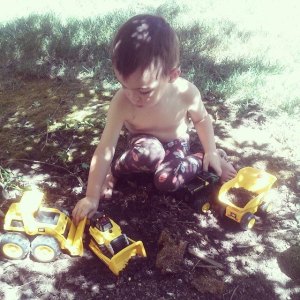Being close to the ground has its advantages. You can fit much more convincingly into small hiding places. When you fall, you can get up that much quicker and keep running. And, being small, you notice more small things. Not just because you are small, but because you are young and you haven’t yet become too busy or too jaded or too bored. You notice the way your toy car drives over the dirt mounds you have created. You notice the way an ant crawls over your arm. You notice how it feels to squeeze mud between your toes. And you don’t just notice these things. You find them magical, beautiful.
This is not to say that adults never do these things. Of course we do. But I don’t think we do them as often or as purely as children do. This is not a novel concept. The “mud between the toes” example is pretty cliche, in fact. But what was novel about the idea, at least to me, was that in doing these things, children are being artists. They are creating their own aesthetic experiences and finding beauty in them. And not because they are told to, or because they are trying to be “creative”, but merely because they are children.
I had considered this before, in thinking about my own childhood and trying to trace a line from what I found beautiful as a child to what kind of person I am today. But my thoughts on the subject became clearer when I read the following quote from The Age of Insight: The Quest to Understand the Unconscious in Art, Mind, and Brain, From Vienna 1900 to the Present by Eric Kandel:
“We think that art is universal because each human was designed by evolution to be an artist, driving her own mental development according to evolved aesthetic principles. From infancy, self-orchestrated experiences are the original artistic medium, and the self is the original and primary audience. Although others cannot experience the great majority of our self-generated aesthetic experiences, from running and jumping to imagined scenarios, there are some avenues of expression that can be experienced by the creator and others.”
This passage is actually a quote that Kandel took from an article entitled “Does Beauty Build Adapted Minds? Toward an Evolutionary Theory of Aesthetics, Fiction, and the Arts” by John Tooby and Leda Cosmides in the journal SubStance. As a side note, I recommend The Age of Insight to anyone interested in art, psychology, neuroscience, history of thought, or any combination of these. It gets a little technical at times and has some hard-to-trudge-through parts, but all in all it is quite insightful and thought-provoking.
What I found worthy of reflection in the above passage was that 1) in play, children are creating art; 2) they themselves are the main, and most times only, audience of this art; and 3) this view broadens and loosens the answer to the age-old question, What is art? The idea that even running and jumping can be considered art was really intriguing to me. The three year old runs really fast and then she stops really fast, and she’s proud of herself that she was able to stop so fast, and she notices what her body feels like when she does that, and she experiences in a special way the relationship she has to her surroundings. That feeling, whatever it is, that’s the art. It’s quite a lovely idea, don’t you think?
Considering this view of childhood experience has also helped me in my role as a mother. My son is now two years old, so he is out there exploring the world and figuring out his place in it, tantrums and all. I have always been conscious of letting him explore, when, say, we’re out on a walk around the neighborhood, and not rushing him when he stops to pick up a rock or run around in circles, et cetera. But even though I knew it was important to let him do this, I would still find myself getting impatient at times if we were not moving along as quickly as I wanted to. But since reading this passage, whenever I start to feel impatient I just remind myself, “He’s creating art.” This helps me see the experience from his perspective and even participate in it with him, which in turn probably gives him more confidence in his own thoughts and observations.
So for all you adults reading this, adults who don’t already consider yourself artists, take heart. Let this idea of experience as art, art as experience, broaden your own outlook on everyday life. Maybe it’s what people mean when they talk about “mindfulness.” I’m not sure. But it’s the idea that there is art to be had everywhere; your being especially conscious and aware is the art, seeing things with the fresh eyes of a child.

